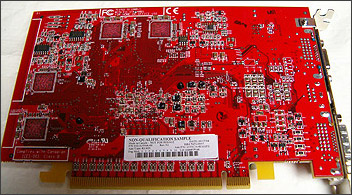Reference Board Examination
There are two key differences between the new reference board and the older one. The first is obviously the cooler. A more squared-off shape, still with a copper base but this time with more base surface area and therefore more internal fins, the new cooler also sports a completely different fan this time around. The fan has thick, flat blades which arc out from the fan's centre section. It seems to move much more air out from the heatsink's top and right edges than the old version. It doesn't use the same mounting mechanism as the old one and the heatsink wobbles precariously over the core if you apply pressure to one of the corners. The older mechanism with a brace across the mounting holes on the rear of the card, as seen here, wasn't that much better.The second key difference is ATI's use of the GC16 variant of Samsung's K4J55323QF GDDR3, omnipresent on graphics cards that need access to high-speed memory these days. Rated to 1200MHz or thereabouts, the GC16 DRAMs give the new board some headroom in DRAM frequency. Both reference boards come clocked at 1050MHz on the memory (525MHz DDR), and with GC20 DRAMs rated to 1000MHz on the previous reference board, ATI were overclocking the memory very slightly. Not so this time around.
Other than that, things look very similar. Component layout seems the same, right down to invidual SMT devices on the rear of the board. Even the PCB serial numbers are the same.
Time for the photographic proof.

Noise and Thermals
The older reference board wasn't exactly the quietest thing under load and the newer one is just as bad. RivaTuner is able to control and monitor the X700 XT's fan, so it was used to check the XT's default and under-load fan settings and temperatures.
Default settings, GPU idle
At the default card settings with the 8.07 hotfix driver, the card runs the fan at 67% of full speed at idle. At that speed it's fairly noisy. Under load, as the temperature rises, the fan steps at two intermediate points before it hits 100% speed. The speed steps don't help the noise profile the board has, since they're quite audible. Then at full speed its very noisy to the point of being obtrusive, and much more so than the first board.
The fan is clearly even louder the second time around, but the GPU definitely seems to be running cooler and no thermal issues (or indeed any issues at all) were seen. It simply seems as if ATI has notched up the cooling performance of the heatsink and fan combination to cope with some possible heat issues seen on the early boards. However, that leaves the XT in the slightly poor position of being a card that might appeal to the eyes in terms of visuals and performance on the screen, but that definitely doesn't appeal to the ears. A simple comparison to the 6600 GT reference board, in terms of noise, leaves the new X700 XT a distant second place.
Salvation comes in the form of RivaTuner. Making it underclock the board slightly when not using the 3D acceleration and forcing it to reduce the fan to ~40% of full speed eliminates the basic noise issue. You then only have to rely on your speakers/headphones to drown out the fan noise when playing games.

RivaTuner's fan control for X700 XT
AIB partner cards will be served well to use something different in terms of cooling.
Want to hear it? Click here for a ~150KB MP3 of the pitch changes, as the card plays a 3D game.











